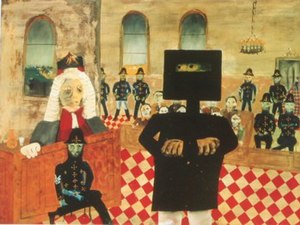The Trial (painting)
| The Trial | |
|---|---|
 | |
| Artist | Sidney Nolan |
| Year | 1947 |
| Type | Enamel paint on Composition board |
| Dimensions | 90.7 cm × 121.2 cm (30 in × 34 in) |
| Location | National Gallery of Australia, Canberra |
The Trial (1947) is a painting by the Australian painter Sidney Nolan.
This painting depicts Ned Kelly's trial, where Kelly is depicted in handcuffs. A judge and several people look at him in the court. The painting is one of a number by Nolan to use enamel paint, usually Ripolin, a commercial paint not intended for art (and nothing to do with true vitreous enamel).
Nolan painted the picture at Heide at Bulleen, Victoria, the home of John Reed and his wife, Sunday.
Sunday Reed may have helped paint the floor of this painting.[1] She supported Nolan while he painted the Kelly series.
This painting is currently in the National Gallery of Australia. The painting was donated by Sunday Reed. Nolan had left the painting among many others at Heide. Although Nolan once wrote to Sunday Reed to tell her to take what she wanted, he subsequently demanded all his works back. Sunday Reed returned 284 other paintings and drawings to Nolan, but she refused to give up the 27 remaining Kellys, partly because she saw the works as fundamental to the proposed Heide Museum of Modern Art.[2] Eventually, she gave them to the National Gallery of Australia in 1977 and this resolved the dispute.
In 1973, Nolan reproduced The Trial on a woven wool tapestry, which was lent to Admiralty House in Kirribilli, the official Sydney residence of the Governor-General of Australia. The tapestry was Sir John Kerr's favourite backdrop when making televised addresses.[3] It is now located at the Federal Court of Australia in Sydney.[4]
References[edit]
- ^ Thomas, Sarah (2004). "Cultivating Controversy (Review of Janine Burke, The Heart Garden: Sunday Reed and Heide)". Archived from the original on 28 October 2007. Retrieved 22 February 2008.
Burke provocatively suggests that Sunday collaborated with him on some of his most famous works, the Kelly series among them. "The Kellys are Sunday and Nolan's swansong," Burke writes, "the last brilliant burst of their creative duet." What is most problematic here is that speculation " that Sunday painted the floor tiles and possibly the patchwork quilt in two of Nolan's paintings " is conveyed as fact. Burke's evidence is unconvincing, the main source being a quote from a subsequent letter from John Reed to Nolan, when the friendship between them had soured, that read: "Your paintings were part of your contribution [to Heide], even though you said Sunday painted them as much as you did " you said all your paintings were for Sunday, and I am quite sure you did not think of them otherwise. They were created with her in a sense which is almost literal, and it is certain without her, without your life at Heide, a great many would never have been painted." Surely the description of Sunday's contribution as being "almost literal" runs counter to Burke's argument?
- ^ Burke, Janine (January 2004). The Heart Garden: Sunday Reed and Heide. Milsons Point, New South Wales: Random House. p. 350. ISBN 1-74051-202-2.
- ^ Whitlam, Gough. Truth of the Matter. Melbourne University Publishing, 2005. ISBN 0-5228-5212-2, p. 228
- ^ federal court of Australia tapestries Tapestries, ICS Sydney. Retrieved 7 December 2012.
External links[edit]
- The Trial — National Gallery of Australia collection

